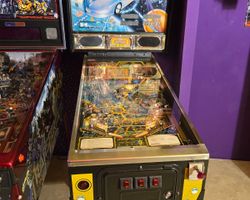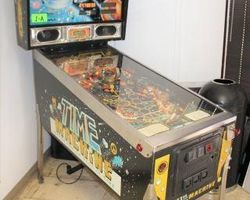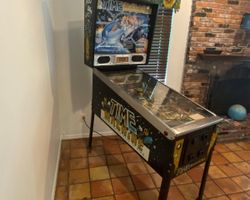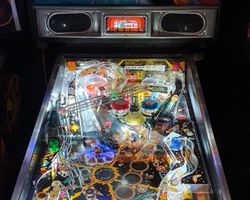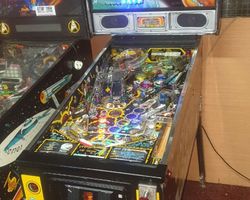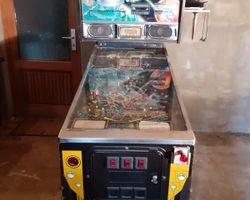Time Machine
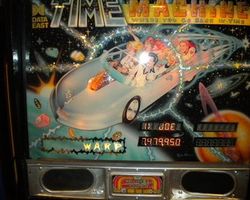
Average Prices: USD $500 to $2,100
Produced: December, 1988
Production Run: 2,896 units
Machine Type: Solid State Electronic
MPU: DataEast/Sega Version 2
Players: 4
Design by: Ed Cebula, Joe Kaminkow
Art by: Kevin OConnor, Margaret Hudson, Kevin O'Connor
Music by: David Thiel
Sound by: David Thiel
Software by: Lonnie D. Ropp, Jerry Koraganis
The "Time Machine" pinball machine, released by Data East in December 1988, invites players to embark on a nostalgic journey through various decades. This fascinating theme was ingeniously brought to life through the efforts of a dedicated design team led by Ed Cebula and Joe Kaminkow, with striking artwork by Kevin O'Connor and Margaret Hudson. The concept draws inspiration from the idea of time travel, blending sci-fi motifs with cultural touchstones from the 1950s to the 1980s, offering a unique experience unparalleled at the time.
Margaret Hudson, one of the artists, added a personal touch by modeling for the hippie character depicted on the backglass, providing an authentic flavor to the visuals. Data East, known for pushing technological boundaries in pinball, produced 2,896 units between December 1988 and April 1989. This unique combination of innovative design and engaging gameplay resonated with audiences, marking a significant milestone in pinball history.
Signature Features and Design
A standout feature of "Time Machine" is its mesmerizing sound system. The machine cleverly emulates the experience of older electro-mechanical (EM) machines when players reach the 1950s decade. During this period, the alphanumeric displays mimic EM scoring reels while the digital sound gives way to a real chime box, evoking an authentic retro vibe. This blend of past and present auditory experiences elevates player immersion, making it a beloved aspect of the game.
The Starwarp ramp, a marvel of design, is another iconic feature. It's not just any ramp—the daring shot opens up intricate light shows and adds layers to the gameplay experience, becoming an addictive challenge and a memorable highlight for players.
Playfield and Mechanics
The playfield of "Time Machine" is a captivating corridor through time, featuring three ramps, three pop bumpers, a vertical up-kicker, and nine standup targets. The layout is meticulously designed to keep players engaged, with shots that range from accessible to challenging, like the skill-demanding Starwarp ramp.
Kevin O'Connor's and Margaret Hudson's artwork infuses the machine with vibrant, era-specific aesthetics. Visual nods to past decades grace the playfield, complementing the lighting design that enhances both gameplay and thematic storytelling.
Gameplay Dynamics
"Time Machine" incorporates gameplay mechanics that invite players into a time-travel narrative. As players progress, the audio changes, reflecting the decade they've entered, complemented by thematic objectives. The machine's multi-ball feature enhances the excitement, while strategic shooting is required to master the ramps and hit high-scoring targets.
The scoring system offers flexibility, allowing players of all skill levels to enjoy success. Yet, it remains challenging enough to keep enthusiasts returning to perfect their strategies, especially for difficult shots such as the left ramp.
Reception and Legacy
Though celebrated for its innovation, "Time Machine" is not without critique. Some enthusiasts have noted issues with flipper strength and ramp difficulty, which can hinder game flow. Additionally, older machines may require regular maintenance—a common sentiment among vintage pinball owners.
Despite these challenges, "Time Machine" holds a cherished place in the pinball community. Its unique theme, nostalgic elements, and engaging audio-visual experiences continue to captivate players. Highly regarded for its creativity and engaging play, the machine maintains a legacy as a favorite among classic pinball aficionados and is often cited when discussing pioneering concepts in pinball design.
 Active Auctions
Active Auctions
 Auction Results
Auction Results
| Cost | Location | Date |
|---|---|---|
| USD $4,000 |  Pennsylvania, United States Pennsylvania, United States |
28 March, 2025 |
| EUR €605 |  Bayern, Germany Bayern, Germany |
26 March, 2025 |
| USD $2,500 |  Florida, United States Florida, United States |
20 January, 2025 |
| USD $2,800 |  Florida, United States Florida, United States |
14 November, 2023 |
| USD $2,900 |  Georgia, United States Georgia, United States |
03 November, 2023 |
| USD $5,000 |  Tennessee, United States Tennessee, United States |
30 August, 2023 |
| USD $6,000 |  Tennessee, United States Tennessee, United States |
28 August, 2023 |
| GBP £2,176 |  Nuneaton, United Kingdom Nuneaton, United Kingdom |
11 June, 2023 |
| USD $3,500 |  Connecticut, United States Connecticut, United States |
21 January, 2023 |
| USD $2,900 |  Missouri, United States Missouri, United States |
14 January, 2023 |


Private Policy · Search Website · Contact Us
All trademarks and copyrighted materials remain property of their respective owners.
All other content copyright 2007 - 2025 Pinpedia.

